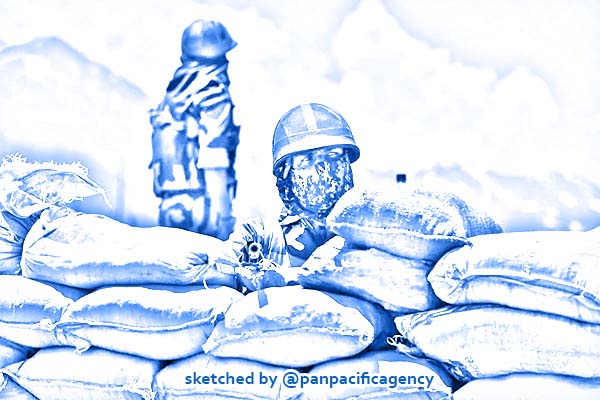China and India to move troops ‘in batches’ from disputed border

Indian soldiers guard a highway leading to the Ladakh region. Photo: DPA. Sketched by the Pan Pacific Agency.
BEIJING, Jul 2, 2020, SCMP. China and India have agreed to disengage their frontline border troops “in batches” to ease ongoing tensions after their latest round of talks, Chinese media has reported, according to the South China Morning Post.
Diplomatic observers said the agreement would prevent accidental clashes but did not mean a retreat of military deployment by the two countries along the Himalayan border and the stand-off would continue.
Nationalist tabloid Global Times, affiliated with People’s Daily, reported late on Thursday that both sides had agreed to take measures to ease tensions in the border areas, citing an unnamed source close to the Chinese border troops. The personnel would disengage “in batches”, according to the report, which observers said meant a withdrawal from different areas by the various groups.
Major General Liu Lin, commander of China’s South Xinjiang military region, and Lieutenant General Harinder Singh, commander of India’s Leh-based 14 Corps, met in Chushul, Ladakh, on Tuesday for the third time in a month. Chinese foreign ministry spokesman Zhao Lijian said “positive progress” had been made to reduce tensions and close communication between the two sides would continue.
The neighbouring forces first clashed in early May over patrols along the Line of Actual Control (LAC) between Indian-administered Ladahk and Chinese-administered Aksai Chin. Tensions rose over the next two months, with brawls at multiple locations along the 3,400km (2,100-mile) border.
Liu and Singh agreed the two sides would disengage from friction points along the disputed border at their last meeting on June 22, a week after their deadliest skirmish in decades when 20 Indian soldiers and an undisclosed number of Chinese were killed in Galwan Valley on June 15.
The Galwan Valley incident disrupted implementation of an earlier agreement to disengage, reached during the first meeting between the two generals on June 6.
Sun Shihai, a researcher on China’s relations with South Asia at the Chinese Academy of Social Sciences, said accidental and fatal clashes on the border could be avoided with the disengagement, but it was not a political settlement to end the stand-off.
“Military backup on the border is still available, and the border stand-off will continue,” he said. “India is purchasing more weapons, and China is also stepping up deployment. Both sides are not able to resolve their dispute and they still have mistrust.
“Both sides are worried that the other side will take risky action, and then they will suffer … and both are aware that the frontline troops have to disengage”.
The stand-off in the Chinese-controlled valley was the first major border confrontation between the two countries since the 2017 Doklam incident, which lasted for more than 70 days. It was also the first face-off in the valley since the Sino-India war in 1962.
The location of the latest stand-off has alarmed Beijing because of its proximity to the autonomous regions of Xinjiang and Tibet. The Aksai Chin includes China’s only direct road link between the two, making military deployment essential in its view.
Lin Minwang, deputy director of Fudan University’s Centre for South Asian Studies, said the stalemate could last until the Himalayan climate forced it to an end. “There is no way to de-escalate right away, also no way to step back,” he said. “The only thing possible for both sides to do is keep a posture for negotiation.”